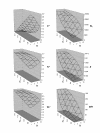Advantages of larval control for African malaria vectors: low mobility and behavioural responsiveness of immature mosquito stages allow high effective coverage
- PMID: 12153709
- PMCID: PMC117646
- DOI: 10.1186/1475-2875-1-8
Advantages of larval control for African malaria vectors: low mobility and behavioural responsiveness of immature mosquito stages allow high effective coverage
Abstract
Background: Based on sensitivity analysis of the MacDonald-Ross model, it has long been argued that the best way to reduce malaria transmission is to target adult female mosquitoes with insecticides that can reduce the longevity and human-feeding frequency of vectors. However, these analyses have ignored a fundamental biological difference between mosquito adults and the immature stages that precede them: adults are highly mobile flying insects that can readily detect and avoid many intervention measures whereas mosquito eggs, larvae and pupae are confined within relatively small aquatic habitats and cannot readily escape control measures.
Presentation of the hypothesis: We hypothesize that the control of adult but not immature mosquitoes is compromised by their ability to avoid interventions such as excito-repellant insecticides.
Testing the hypothesis: We apply a simple model of intervention avoidance by mosquitoes and demonstrate that this can substantially reduce effective coverage, in terms of the proportion of the vector population that is covered, and overall impact on malaria transmission. We review historical evidence that larval control of African malaria vectors can be effective and conclude that the only limitations to the effective coverage of larval control are practical rather than fundamental.
Implications of the hypothesis: Larval control strategies against the vectors of malaria in sub-Saharan Africa could be highly effective, complementary to adult control interventions, and should be prioritized for further development, evaluation and implementation as an integral part of Rolling Back Malaria.
Figures

References
-
- Lengeler C. Insecticide treated bednets and curtains for malaria control. Cochrane Library Reports. 1998;3:1–70.
-
- Beier JC, Killeen GF, Githure J. Short report: Entomologic inoculation rates and Plasmodium falciparum malaria prevalence in Africa. Am J Trop Med Hyg. 1999;61:109–113. - PubMed
-
- Lines JD, Myamba J, Curtis CF. Experimental hut trials of permethrin-impregnated mosquito nets and eave curtains against malaria vectors in Tanzania. Med Vet Entomol. 1987;1:37–51. - PubMed
Publication types
MeSH terms
Substances
Grants and funding
LinkOut - more resources
Full Text Sources
Other Literature Sources
Medical
Research Materials

